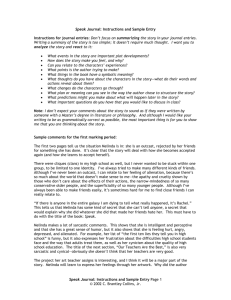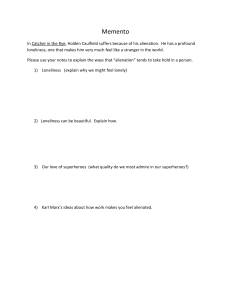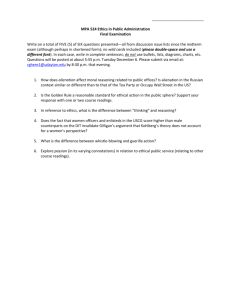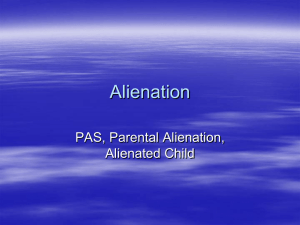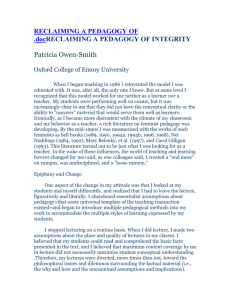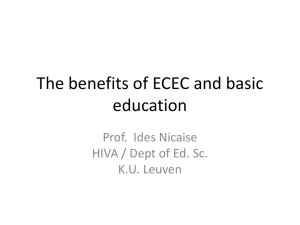ALIENATION IN HIGH CONFLICT CASES
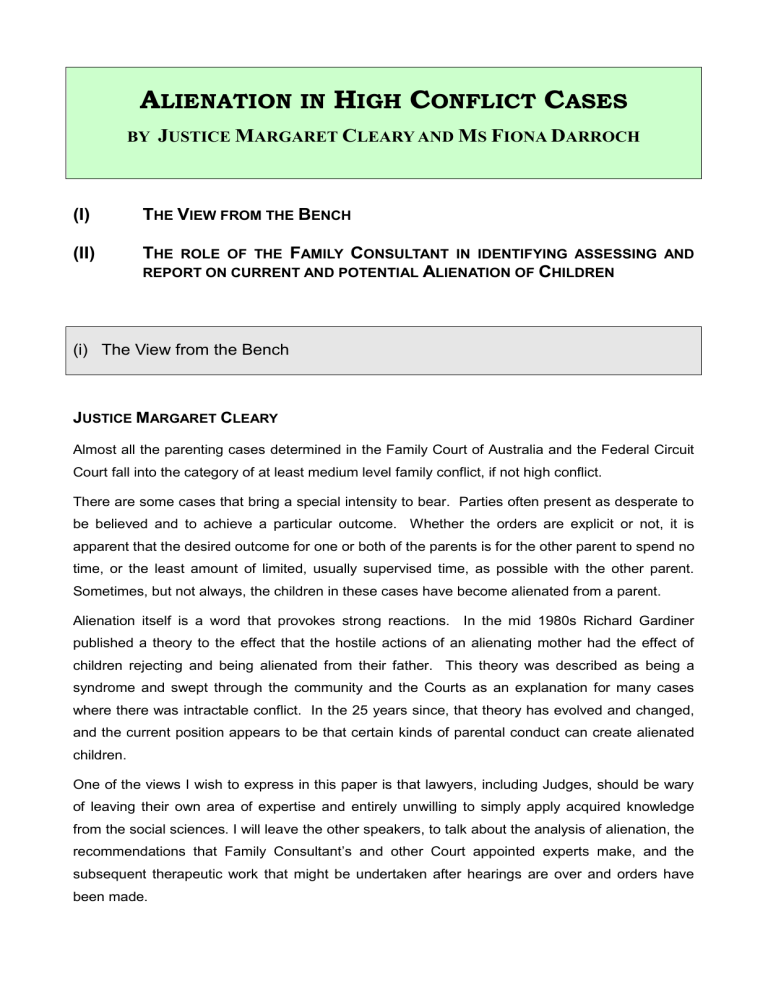
A
LIENATION IN
H
IGH
C
ONFLICT
C
ASES
BY
J
USTICE
M
ARGARET
C
LEARY AND
M
S
F
IONA
D
ARROCH
(I)
(II)
T HE V IEW FROM THE B ENCH
T HE ROLE OF THE F AMILY C ONSULTANT IN IDENTIFYING ASSESSING AND
REPORT ON CURRENT AND POTENTIAL A LIENATION OF C HILDREN
(i) The View from the Bench
J USTICE M ARGARET C LEARY
Almost all the parenting cases determined in the Family Court of Australia and the Federal Circuit
Court fall into the category of at least medium level family conflict, if not high conflict.
There are some cases that bring a special intensity to bear. Parties often present as desperate to be believed and to achieve a particular outcome. Whether the orders are explicit or not, it is apparent that the desired outcome for one or both of the parents is for the other parent to spend no time, or the least amount of limited, usually supervised time, as possible with the other parent.
Sometimes, but not always, the children in these cases have become alienated from a parent.
Alienation itself is a word that provokes strong reactions. In the mid 1980s Richard Gardiner published a theory to the effect that the hostile actions of an alienating mother had the effect of children rejecting and being alienated from their father. This theory was described as being a syndrome and swept through the community and the Courts as an explanation for many cases where there was intractable conflict. In the 25 years since, that theory has evolved and changed, and the current position appears to be that certain kinds of parental conduct can create alienated children.
One of the views I wish to express in this paper is that lawyers, including Judges, should be wary of leaving their own area of expertise and entirely unwilling to simply apply acquired knowledge from the social sciences. I will leave the other speakers, to talk about the analysis of alienation, the recommendations that Family Consultant’s and other Court appointed experts make, and the subsequent therapeutic work that might be undertaken after hearings are over and orders have been made.
E ACH CASE ON ITS OWN FACTS
In my view, there is nothing more important than that a court hearing is a process of finding of fact and an application of the law to the facts found. It is not an exercise of identifying a type of case, that is, of characterising a case as part of a group identified by:
sexual abuse allegations;
domestic violence;
drug and alcohol abuse;
mental illness; personality disorders;
relocation
alienation.
Each case is a dispute, usually between parents, but sometimes others, as to appropriate arrangements and decision making for children. It is not an opportunity to apply labels outside legal expertise. Judges may know something ,or very little about social science. Whatever the state of that knowledge it cannot be brought to bear on a case without there being evidence.
It can be irresistibly interesting to know that personality disorders can be in the categories: paranoid; anti-social; histrionic; obsessive/compulsive; narcissistic; anxious; dependant; and avoidant.
Descriptions of those personality types given by specialists in the area, can resonate with lawyers in terms of their own experience with particular clients and cases they have been involved in, but any attempt to understand or present a case in that way can lead to a formulaic response, for example, this is a case of alienation and therefore the outcome will be a change of residence.
The decision in the case of McGregor & McGregor decided in the Full Court of the family Court on
28 May 2012 is salutary reading for all lawyers, including Judges. This was a decision where a change of residence had been ordered, moving three children resident with their father to live with their mother. At one point in the judgment at first instance, there is this statement:
I am satisfied that this case is a classic case of parental alienation, perpetrated by the husband against the wife.
His Honour then turned to consider the effects of alienation and quoted from certain experts on this issue. Other research discussed in the article by those authors and the effects on children of alienation in the short and long term was also mentioned.
The Full Court in overturning the decision, focused on these issues:
(i) section 144 of the Evidence Act. This section relates to common knowledge;
(ii) the issue of natural justice, that is, the need to put everything that a Judge takes into account before the parties to give them an opportunity to make submissions;
(iii) The criteria for entry into evidence of an expert opinion.
One of the ways that courts are informed is through the evidence of an appropriately qualified expert. A judge may then ask that expert questions within that area of expertise.
My task as a Judge is to find facts and determine issues in disputes, not to make assumptions. I cannot assume that high conflict is driven by both parties equally, that if there is high conflict equal shared parental responsibility is inevitably unavailable, or that sole parental responsibility to one parent is the only possible course.
The focus is on the outcome for the particular children involved, certainly not punishment or reward for parents, whatever their conduct has been, and the pathway for analysing the best interests for children is set out in the Family Law Act 1975 (Cth).
One of the benefits of being a Judge is having access to the perspective of all parties, rather than being confined to advocacy for one party. Ideally the perspective of all parties is fully presented to the Court. Many cases are not ideal. There is often a combination of some or all of these factors, namely:
(a) That one or both parents is seeking sole parental responsibility for himself or herself, residence and no contact with the other parent.
(b) There is a family report or joint expert report that recommends time with both parents, or if resistance by one of the parents continues, a change of residence.
(c) There is a psychiatric assessment in relation to one or both parties that diagnoses a mental illness, a personality disorder, or the consequences of drug and alcohol abuse.
(d) There is an Independent Children’s Lawyer who has hopefully interviewed the children, and been actively engaged in obtaining as much objective material as possible; for instance from schools, police, doctors, hospitals, past employers and others.
Talking to children assists an Independent Children’s Lawyer in high conflict cases to form a view. There may be a realistic personal reason for children to resist contact or reject a parent, or a child’s difficulties with relationships may arise from the conduct of parents.
Independent Children’s Lawyers, sometimes attend interviews conducted by Family
Consultants in preparation for Family Reports.
(e) There is a lawyer who has succumbed to being a champion for their client, has become defensive of the client’s position despite the evidence or lack of it, or has become dismissive of a client’s position, or there may be lawyers who have been appropriately
(f) confronting with a client who dismisses them as being “not on my side”, or “not understanding ” or “part of a conspiracy with the Court”. This can happen at any time before and during the course of the hearing.
An expert who provides clear opinions, considering alternate positions held within their area and exposing their reasons for opinions expressed.
Finally, can I say this. Participating in this presentation has made me realise that from the point of view of therapists who deal with children after the judgment is delivered in such cases, their work really starts when mine is over. The Court sometimes implements a blunt solution such as change of residence, based on a least worst alternative or a decision that the child be placed with the parent most likely to support a relationship with the other parent.
Accordingly, the exposure in the reasons for judgment and structured orders, which to the greatest extent possible are unambiguous, are most likely to assist in ongoing work for affected children.
(II) T HE ROLE OF THE F AMILY C ONSULTANT IN IDENTIFYING ASSESSING AND
REPORTING ON CURRENT AND POTENTIAL A LIENATION OF C HILDREN
M S F IONA D ARROCH , F AMILY C ONSULTANT
The role of ‘Family Consultant’ to the Family Court and the Federal Magistrates Court, involves working with both children and parents in cases that usually involve ongoing parental conflict featuring a lack of trust and poor communication. A common scenario is that one parent will be seeking to increase or maintain their time with the children, while the other parent will be seeking to reduce that time or to limit the extent of the other parent’s involvement in the life of the children.
Each parent will come prepared with reasons as to why their proposal should be accepted, together with their version of events leading up to the current litigation. At times, these versions are so incompatible with one another so as to lead one to wonder whether these two people have ever met, let alone had a relationship with one another.
It is common for allegations to be raised about the other parent; these can include allegations of family violence, child abuse (emotional, sexual, physical or neglect) and substance abuse.
More often than not, these allegations are used as a basis for one parent wishing to limit the other parent’s time with the child. Sometimes, a parent will suggest that the child is unwilling to spend time with the other parent on the basis of the child’s own experiences with that parent and that the child has voiced a strong opinion in that regard.
There are other cases where the complaints against the other parent appear to be quite insignificant and petty; yet the parent is still suggesting that the child is very resistant to spending time with the other parent and that the child’s wishes need to be taken into consideration prior to any Parenting Orders being made.
It is often the case that parents have been given inaccurate or conflicting information regarding the weight the Court places on the child’s wishes or views and will insist that the child is old enough to decide for themselves whether they will spend time with the other parent, regardless of whether that child is a toddler or a teenager.
At this point in time, a ‘Child Inclusive’ appointment is usually ordered. The child or children are interviewed by the Family Consultant without the parents being present and feedback regarding their current developmental needs, their emotional and psychological wellbeing and their perception as to the situation they have found themselves in is given to both parents separately by the Family Consultant.
The Child Inclusive process can be a very powerful instrument leading to changes in parental attitudes and behaviour – but only if the focus of the parents is on their child’s needs, as opposed to their own agendas.
Faced with child who is openly declaring a preference for one parent over the other and who is articulating a wish to reduce time spent with the other parent, the Family Consultant will need to take into consideration a number of factors.
C HILD D EVELOPMENT F ACTORS
At one end of the spectrum you have very young children who will often present as being upset over having to separate from a primary carer to spend time with the other parent. This is most typically found at around 2½ years of age and it is quite common for these children to resist by hiding, holding onto a parent or crying hysterically. They may also present as angry and upset upon their return to the primary carer.
In a Family Court setting it is not unusual for the primary carer to blame the other parent for somehow hurting or abusing the child in some way so as to cause the negative behaviour; similarly, the other parent tends to attribute the negative behaviour to poor parenting on the part of the primary carer and may even voice concerns that the primary carer is deliberately doing something to cause the child’s behaviour.
What is really being played out here is a child who has a strong attachment to a primary carer and who is becoming distressed at separating. It does not normally reflect the quality of the relationship with the other parent. The child is will usually settle once with the other parent and will usually stop showing signs of distress within a very short period of time after changeover has occurred if they feel safe and comfortable with the other parent. This type of separation anxiety is developmentally normal and to be expected (for example: it is often seen in children who attend childcare).
Should the separation anxiety persist, it may mean that the child is leaving the primary carer for a time period that is longer than they can cope with and if this situation is rectified (for example by having overnight time cut back to day time or by making day visits of shorter duration and having them occur more frequently) then the separation anxiety will usually resolve by the time the child is a little over three years of age.
If the parents are child-focused and are receptive to feedback around their child’s developmental needs, then this issue is easily resolved. However, if this isn’t the case (for example: when there are child-support considerations that are prioritised over and above the needs of the child) then the parental conflict will continue and the child will continue to be negatively affected by unsuitable parenting arrangements.
Affinity: By the time the child is around 3½ years of age they are usually quite capable of having an equally strong reliance on two parents simultaneously (i.e. either parent is capable of meeting the child’s needs). They may also have a strong attachment to both parents while still presenting with an affinity or preference for one parent in particular. This may be due to age, personality or gender reasons and it does not signify a rejection of the other parent. An example of this would be for the child to usually be happy to spend time with the other parent but refusing to do so when he feels ill.
Alliance: Between 5 to 11 years of age children tend to learn by rote and imitation rather than by thinking for themselves. They have quite limited abstract reasoning. One of the consequences of this is that when there is overt parental conflict the child will take the view that one parent is right and the other parent is wrong. It is not possible for both parents to be right. While younger children
(up to around 8 years of age) will become sad as a result of their experience of the ongoing parental conflict, children from between the ages of 9 to 12 years tend to become angry. While the younger children seem to actively fight feelings of anger towards a parent, the older age group are active in expressing their hostility towards the parent they perceive to be at fault in the situation. A lack of warmth or poor parenting by the rejected parent will actively contribute towards the alignment process. Parents can also play an important role in aligning a child by placing loyalty demands upon them and by presenting themselves as vulnerable, at risk of harm or by relying on the child to meet the needs of the parent rather than the other way around.
Estrangement: As the child becomes older they will become more susceptible to becoming aligned with a preferred parent and more rejecting of the other parent, particularly if that parent consistently presents with a strong negative view of the preferred parent to the child. Sadly, there are parents who will take advantage of this situation and use the anger of the child to turn the child against the other parent in order to achieve revenge or to satisfy their own needs or insecurities.
This is a dangerous strategy as, unless this anger is successfully resolved, children of this age are going to suffer significant and permanent problems, particularly as they move into adolescence and add hormones to the mix. As children start to become alienated they can become obnoxious and hard to disc ipline and the rejected parent may further inflame the situation if they present with ‘poor reactive parenting’.
Adolescence: With the commencement of high school (at around 12 or 13 years of age) there is another marked psychological transition in the ch ild’s development. Here the need for independence and the opportunity to make decisions for themselves becomes increasingly important. However, this capacity is based on pseudo maturity – although the child considers that they have the maturity to be able to decide for themselves and work out what is best for them, this is within the limits of being a 13+ year old with limited life experiences to draw on. Major decisions require life experience, particularly with regards to understanding actions and long term consequences. During adolescence it is normal for a teenager to prefer to spend time with their peers as opposed to family; however, this is not a good enough reason for them to stop spending time with parents or family members if this will damage important relationships or undermine parental authority; balance is called for. In cases of long term, high level parental conflict the adolescent may view an alignment with one parent together with a rejection of the other parent as the only way possible to get some respite from the conflict; if this is the case then consideration should be given to the child’s wishes as having time out from the conflict can be beneficial and lead to spontaneous reunification at a later time. However, if there is clear and compelling evidence that the child is doing poorly in other domains of life (for example: emotional and behavioural problems
like depression, conduct disorder, poor achievement and attendance at school, or significant difficulties with peer relationships) then the presumption that the child should remain in the primary care of the person with whom he or she is more comfortable may need to be reviewed.
Realistic Estrangement: There may be very good reasons for a child to become estranged from a parent: for example, if the child has witnessed family violence or has been abused themselves or has experienced neglectful or poor parenting. Such estrangement may manifest itself in behaviour such as reluctance to spend time with that parent or absolute refusal to do so; however, most young children do seem to want some sort of contact with both parents, even in circumstances where there has been abuse.
Abuse and Family Violence: As previous explained, family violence can lead to realistic estrangement with the child refusing to spend time with the perpetrator as a means of selfprotection. Abusive and alienating behaviour may also be related, with the perpetrator of the abuse using the alienating behaviour as a means to further undermi ne or sabotage the child’s relationship with the victim parent. The child may come to identify with the abusive and more powerful parent over time (this is particularly true for boys who tend to emulate the negative behaviours they have been exposed to with both the victim parent and with others, usually of the same gender).
To recap: Cases involving the question of alienation include a wide range of family dynamics. It is necessary to distinguish among families in which there are realistic estrangements, normal or developmentally expectable preferences, alignments and attachments – as well as to determine in which cases a child is psychologically alienated from a parent.
H OW D OES AN A LIENATED C HILD P RESENT AT I NTERVIEW ?
The essential definition is that “ the alienated child freely expresses unreasonable negative feelings and beliefs, such as anger, hatred, rejection and/or fear towards one parent, that are significantly disproportionate to the child’s actual experience with that parent” ( Kelly &
Johnston , 2001)
‘Alienated’ children usually turn up to an interview with a seemingly rehearsed litany of the rejected parent’s faults and negative characteristics. Sometimes, it can be the case that the child is responding to a fear of losing time with a preferred parent or because they are faced with increasing time with a parent who has some limitations to their parenting ability. This would be considered ‘situational alienation’ as it is likely that the child’s behaviour is aimed at influencing the assessment process or outcome – rather than that the child is truly alienated.
It is useful to find out how long the child has been presenting in this way as well as to whom. As children become more entrenched in their alienation, they tend to tell more people about the rejected parent’s failings and may expand their complaints to include the rest of that parent’s family, friends and even pets. They start to tell more and more people (e.g. teachers and
psychologists) and sometimes, these ‘support networks’ end up reinforcing the child’s distorted beliefs.
The child’s words will often sound scripted or rehearsed and they may echo verbatim the words of the alienating parent without any real understanding of the concepts they are describing (for example: you may have a 5 year old telling you that a parent is ‘verbally abusive towards me’).
The well documented ‘black and white thinking’ as shown by alienated children with regards to the rejected parent who is seen as ‘all bad’ and towards the preferred parent who is usually idealised, may also extend to other people in the child’s life such as teachers, family and friends (for example: a child may turn against a teacher who they perceive as being ‘mean’ to them – while this may not be the case at all and they may also turn against those who they see as supporting the rejected parent). School aged children have a strong need to see their parents as good and alienating behaviour can cause distortions in their developing moral identity with possible long term consequences.
It is useful to explore whether the child is able to recall any positive memories of the rejected parent. Children will often state that they have no positive memories of spending time with the rejected parent, despite apparent evidence to the contrary. Often alienated children will present as emotionally ‘shut down’ and this can be in response to the high level of parental conflict they have experienced; however, it can also be a defence mechanism where a child has an ‘enmeshed’ relationship with the aligned parent as it prevents the child from using good reality testing which may threaten the alignment.
It is also useful to look closely at how the child is behaving and to compare this to what the child is saying. For example: if a child is highly resistant to spending time with a parent and spends the time yelling and screaming and demeaning the rejected parent, the child would be seen as more severely alienated than the child who is equally resistant before the visit but who is able to engage with and possibly find some enjoyment with the rejected parent during the visit itself. While it is useful to collect information from both parents and from other more neutral informants such as teachers or contact centre staff for a Family Report, direct observations are invaluable during the assessment process.
It is always interesting (although sad) to note that a child may be more than willing to discuss their interests and lives with a relative stranger such as the Family Consultant, yet when asked the same questions by the rejected parent, their response is usually overwhelmingly hostile and negative.
It is useful to observe transitions between the parents in order to determine whether the child’s rejecting behaviour only occurs in the presence of the other parent or if negative attitudes soften when that parent is removed from the equation.
Although pre-schoolers and younger school-age children are not likely to be developmentally capable of being alienated (this is because they cannot, cognitively and emotionally, maintain a
cohesive, enduring rejection of a parent in the face of positive interactions with that parent) they may present with heightened separation anxiety as a result of anxiety induced by the suggestion that they are entering a ‘dangerous situation’. This anxiety may reappear at the transition stage, particularly if they are aware that it is considered ‘unacceptable’ to have enjoyed spending time with that parent.
What happens next?
If the situation is assessed as being likely to evolve from alignment to alienation or if a parent or child is particularly resistant to suggestions made to rectify the situation, it is likely that a comprehensive Family Report will be ordered. It is important to examine the allegations and to ensure that the safety of the parents and the children is prioritised; for example: it may be necessary to undertake an assessment of the family violence looking at potency, pattern and primary perpetrator indicators. If there are sexual abuse allegations these will also need to be priori tised and explored fully. An Independent Children’s Lawyer may need to be appointed and it may be necessary to subpoena records from the police, schools and other medical and psychological health service providers.
It is considered important to maintain contact between the child and the rejected parent during the course of the assessment process as this may help to prevent further entrenchment of the child’s views. Because it may take months between appointments and because it may have already been months since the child has last spent time with the rejected parent, it is important to focus on addressing this issue as a matter of priority. One way to do this is to offer the parents the option of attending a ‘Keeping in Contact Program’ such as those run by Unifam where counsellors work with the parents and the child in order to find some resolution to the problem. Occasionally, the child’s attendance at such a program may be ordered by the Court. The role of the Family
Consultant is to assess and case-manage rather than to provide therapy to the child or to the family.
The Court may also order that the child spends time with the rejected parent at a Contact Centre, where supervision is provided and records kept of the interactions between the parent and child as well as any information provided by the other parent at changeover. These records may be a very useful source of information to the Court.
It is important to cast a wide net in order to obtain as much information as possible from extended family members, teachers, counsellors and family doctors. It is also important to keep in mind that some of these people may be actively urging or promoting the rejection process as it is quite common to find the development of ‘warring camps’ in polarised families and for others to be conscripted into these camps by being required to take a stand in the conflict. In most families in which a child has become alienated from a parent or in which alienating processes are occurring, it is most useful to think in terms of the likelihood that all members of the family are making contributions.
In alienated families with multiple children it is important to examine the family dynamics, including establishing which children are alienated and which are not. Although one may find only one alienated child in a family (usually the eldest), there may be a risk that the other children will become alienated in the future as the older co-opts the younger ones into the negative stance.
Children’s wishes and views should be explored and recorded. It will be necessary to assess how much weight should be given to these in relation to the child’s developmental stage and with regard to the alienation process.
Testing: While there are no test profiles that identify abusers, batterers, alienating parents or abused children, cognitive assessments can help to identify the parents’ intellectual strengths and weaknesses, style of thinking and problem solving and the degree to which their cognitive functioning may be disrupted by underlying emotional factors. Personality tests can also be useful to confirm or rule out the presence of problematic personality traits alleged by the aligned parent. It is fairly common for one if not both parents to ‘diagnose’ the other parent with some sort of personality disorder. In a Family Court setting, testing is not usually carried out unless an agreed
Single Expert who specialises in this area has been appointed to prepare the Family Report.
Self-Report Scales: Beck Youth Inventories: These can be used with children between the ages of 7 to 18 year old and provide an indication as to how the child sees himself in terms of being depressed, anxious, engaging in disruptive behaviour and with regards to self-esteem. They also provide a comparison with other children of similar age and gender and can be used as a pre and post measure of the child’s progress over time. This can be extremely helpful as it provides a very concrete way of showing both parents and children whether things are getting better or worse from the child’s perspective.
To recap: The main focus of the Report should be on the family dynamic and it is important to refocus attention from the question of who is to blame to the question of how a child is being harmed and what can be done.
R ECOMMENDATIONS :
The recommendations need to specify both the therapeutic interventions and the parenting arrangements and should be as specific and detailed as possible (to the point of recommending a therapist for the child so that the aligning parent doesn’t get a chance to use delaying tactics to stall therapy).They should cover the following: all parenting arrangements – including communication strategies; sharing of decision making; how much time the child will spend with each parent and where changeover will occur; what will be taken to the other parent’s home and whether telephone communication / internet communication will be permitted; rules to minimize and avoid conflict; how the orders will be monitored and how contraventions will be dealt with and a proposal for evaluative updates.
Change of residence : A change of residence may be recommended as being in the child’s best interests in cases where the alienating parent ’s personality is disordered and enmeshed with that of the child or where the alienating parent is intractably opposed to facilitating the child’s ongoing relationship with the other parent. It is usually seen as the most extreme judicial remedy but in more severe alienation cases it may be the only way to change the situation for the child, particularly if that child is in danger of ongoing emotional and psychological harm if they remain in the care of the alienating parent. Some children are able to change very quickly with a residence change; however, some children will not be able to cope with the change and the decision may need to be reversed. Rapid change is usually called for and it may be necessary to suspend the time with the non-residential parent as the alienating parent may continue to undermine the relationship. It is more common on an interim basis than on a final basis.
V ERY B RIEFLY : W HAT HAPPENS IF YOU DO NOTHING IN CASES WHERE ALIENATION IS FOUND TO
BE LIKELY TO OCCUR OR WHERE IT IS ALREADY OCCURRING ?
Beliefs about the rejected parent can become entrenched and relationships severed on a permanent basis. If the child does ‘flip’ and change alliances during adolescence there is a high chance that this won’t last and that the child will ‘bounce’ between parents rather than learning how to deal with conflict. These children are more likely to be early school leavers; to leave home early and to go on to have broken relationships themselves. They are also more likely to find themselves repeating the cycle by becoming alienating parents themselves with their own children when their own relationships end. As in all other areas of life, early identification of potential problems and early intervention will produce the best results on a long term basis.
